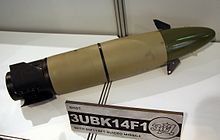| 9M119 Svir / 9M119M Refleks AT-11 Sniper | |
|---|---|
 Version 9M119F1 | |
| Type | ATGM |
| Place of origin | Soviet Union |
| Service history | |
| In service | 1980s–present |
| Used by | Russia China India Serbia South Korea Bangladesh |
| Production history | |
| Designer | Tula Machinery Design Bureau (Tula KBP) |
| Designed | 1980s |
| Manufacturer | Degtyarev plant |
| Unit cost | $37,500 (2012)[1][2] |
| Produced | 1980s–present |
| Variants | 9M119M |
| Specifications | |
| Mass | 16.5 / 17.2 kg[3] |
| Diameter | 125 mm |
| Warhead | Tandem hollow-charge |
| Warhead weight | 4.5 kg |
Operational range | 4,000 / 5,000 m |
| Maximum speed | Subsonic |
Guidance system | Laser beam riding |
Launch platform | 125 mm smoothbore guns |
The 9M119 Svir, 9M119M Refleks and AT-11 Sniper by NATO[4] are laser beam riding, guided anti-tank missiles developed in the former Soviet Union. The two missiles are similar, but vary in range and launch platform. Both are designed to be fired from smooth bore 125 mm tank and anti-tank guns (2A45, 2A46 and 2A46M). Their NATO reporting name is AT-11 Sniper. The name Svir comes from the River Svir, while Refleks means reflex. The 9M119 replaces, or supplants, the 9K112 Kobra.
Refleks
The Refleks is launched through cannons of T-90 and Serbian M-84AS and some versions of the T-80 and T-84 tanks. It has also been produced by the People's Republic of China for use with its Type 99 tank.[5] The Indian defence ministry has signed a contract with Bharat Dynamics Limited (BDL), a public sector company under Department of Defence Production, for supplying Invar Anti Tank Guided Missiles to the Indian Army. BDL has been manufacturing these missiles under technical collaboration with Rosoboronexport.[6] It can also be fired from the 2A45 Sprut-B anti-tank gun.[7] The Invar 9M119M and Invar 9M119M1 (Invar-M) are fired from a 125 mm gun. It is ejected by the 9Kh949 ejecting device and the rocket motor is ignited after the missile leaves the barrel. Ram air collected by the air intakes in the nose is used to provide power to move the control fins. The 17.2 kg (37.8 pound) missile is 690 mm (27.1 inches) long and has pop-out fins (with a 250 mm/69 girth span) that aid in guidance. The missile is guided by the modulated laser beam steered by the tank gunner. The missile has a maximum range of 5,000 meters at a speed of 350 meters per second (17.69 seconds max flight time). The Invar enables the tank to hit targets at twice the range of the 125mm shells. The tandem warhead can penetrate up to 900 mm of armor (35.4 inches). Missile 9M119M "Invar" was put into service in 1992, and the missile 9M119M1 "Invar-M" in the second half of the 1990s.[8][9] There are also high explosive versions produced named 9M119F and 9M119F1 which are intended to defeat enemy personnel.[10]
Svir
The Svir is used with the T-72 and T-80 tank series.
Similar weapons
- United States: MGM-51 Shillelagh used with the M551 Sheridan light tank, and the short lived M60A2 MBT.
- United States: XM1111 Mid-Range Munition which was attempted to be developed for the M1A2 SEP Abrams MBT.
- Russia: 9K112 Kobra (AT-8 Songster) is also fired through 125-mm smoothbore gun tubes.
- Pakistan: Baktar Shikan is a portable system which can be fired through multiple platforms
- Israel: LAHAT, used with their 105 and 120-mm gun tubes.
- France: ACRA 142mm anti-tank missile, tested on a version of the AMX-30 MBT.
- Ukraine: Kombat tandem-warhead ATGM with a 5,000-m effective range, fired from 125-mm smoothbore guns. 950 mm penetration.[11]
- Iran: Reversed engineered version of the Svir with max range of 4,000 meters named Tondar.[12]
Specifications
- Range:
- Svir: 75 to 4,000 m
- Refleks: 75 to 5,000 m
- Weight (complete round):
- Svir: 28 kg
- Refleks: 24.3 kg
- Missile Weight:
- Svir: 16.5 kg
- Refleks: 17.2 kg
- Warhead: Tandem HEAT
- Penetration: 700–900 mm of RHA
- Time of flight to 4,000 m: 11.7 s
- Time of flight to 5,000 m: 17.6 s
Operators
Current operators
 Bangladesh:[13] Used by the Bangladesh Army as ATGM for its Type 59G(BD) Durjoy tanks
Bangladesh:[13] Used by the Bangladesh Army as ATGM for its Type 59G(BD) Durjoy tanks China
China Cyprus
Cyprus Georgia
Georgia India
India Russia
Russia Morocco
Morocco Vietnam
Vietnam
Former operators
 Soviet Union - Passed on to Russia.
Soviet Union - Passed on to Russia. South Korea - Retired in early 2019, with the T-80U Main battle tanks.
South Korea - Retired in early 2019, with the T-80U Main battle tanks.
References
- Citations
- ^ "Индия купит десять тысяч российских противотанковых ракет". Archived from the original on 2012-10-21. Retrieved 2012-10-19.
- ^ "Archived copy". Archived from the original on 2012-10-21. Retrieved 2012-10-19.
- ^ a b "Archived copy". Archived from the original on 2018-05-07. Retrieved 2018-12-11.
- ^ "Archived copy". Archived from the original on 2018-11-16. Retrieved 2018-04-07.
- ^ "Janes Armor and Artillery Upgrades". Archived from the original on 2012-06-30.
- ^ http://in.rbth.com/economics/2013/08/21/india_signs_471_million_contract_for_russian_invar_missiles_28667.html
- ^ Jane's Ammunition Handbook 2003-2004. Janes Information Group. 2003.
- ^ "Archived copy". Archived from the original on 2018-09-26. Retrieved 2014-12-19.
- ^ "Archived copy". Archived from the original on 2014-10-26. Retrieved 2014-12-18.
- ^ "Archived copy". Archived from the original on 2014-12-22. Retrieved 2014-12-22.
- ^ Jane's Armour and Artillery 2005–2006, p 133.
- ^ http://modlex.ir/cgi-bin/store.pl/page=product.html/pid=MXF05-000160
- ^ "How Many Tanks Bangladesh Army Has?". Retrieved 27 December 2019.
- Bibliography
- Jane's ammunition handbook 2003–2004.
- RED THRUST STAR : U.S. Forces Command OPFOR Training Program
- FM 3-19.4 : Weapon Appendix